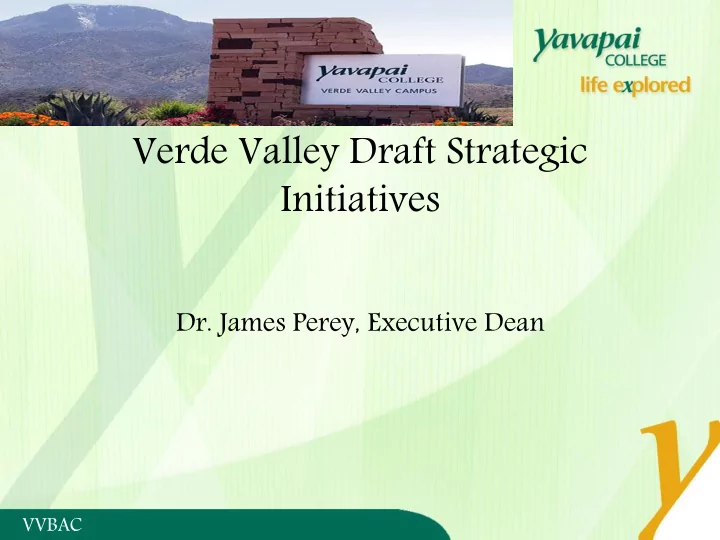

Verde Valley Draft Strategic Initiatives Dr. James Perey, Executive Dean VVBAC
Process Phase I — Environmental Scan The environmental scan pulled information from national, state, county, and local levels to examine trends in the areas of competition, demographics, economics, labor force, education, and technology. The scanning data was then shared with stakeholders and College leadership to inform decision making in the planning process. Phase II — Strengths, Weaknesses, Opportunities, and Threats (SWOT) The College conducted face-to-face SWOT exercises with a diverse group of stakeholders including departments/divisions, student services, administrative services, and student groups. More than 80 individuals participated in the Strengths, Weaknesses, Opportunities and Threat exercises. The SWOT information in conjunction with the environmental scan provide the foundation for subsequent phases of the strategic planning process. Phase III — Strategic Initiatives and Goals A content analysis of the SWOT data and key trends from the environmental scan were used to identify the top strategic initiatives and goals needed to successfully achieve the initiatives. These were deliberately prioritized goals against the Board’s Ends and could be completed over the planning horizon period. Phase IV — Develop Tasks and Annual Tactical Plans Phase V — Implement Annual Tactical Plans Phase VI — Monitoring the Strategic Plan Phase VII — Assessment of Progress Phase VIII — Improve Planning Process VVBAC
Strategic Initiatives Student Success-1 Economic Responsiveness-2 Engaged Community-3 Talent Development-4 Fiscal Stewardship-5 1. Establish Academic 1. Explore current and future 1. Strengthen marketing and 1. Institutionalize regular 1. Identify capital Pathways to enhance program CTE offerings and delivery recruitment, in the Verde climate surveys (1.1) improvement needs (1.1, and degree completion model (1.1.1, 1.2) Valley (1.1.1, 1.1.2, 1.1.3, 1.2) (1.1.1, 1.1.2.) 1.3) 2. Evaluate and develop 2. Increase partnerships with 2. Increase social and 2. Expand professional standard systems to enhance Business and Industry (1.1.1, cultural opportunities to development opportunities student success (1.1.1, 1.1.2, 1.2) Verde Valley residents (1.3) for all faculty and staff (1.1) 1.1.3) 3. Strengthen internal and external community relations through improved communication (1.3) 4. Explore blending for- credit, community education, and Osher Life Long Learning (1.1.3) VVBAC
Student Success-1 VVBAC
1. Establish Academic Pathways to enhance access, program and degree completion (1.1.1, 1.1.2.) • The need to examine current academic pathways, potential new pathways, identify issues of access and completion, and develop plans and strategies to overcome challenges. VVBAC
2. Evaluate and develop standard systems to enhance student success (1.1.1, 1.1.2, 1.1.3) Students may need academic, social, and in some cases, financial support, especially those that enter college academically under-prepared and struggle to succeed in college. Student success is multifaceted in that there is much research focusing on best practices that can assist students in being successful in higher education. VVBAC
Economic Responsiveness-2 VVBAC
1. Explore current and future Career and Technical Education offerings and delivery models (1.1.1, 1.2) VVBAC
Engaged Community-3 VVBAC
1. Strengthen marketing and recruitment, in the Verde Valley (1.1.1, 1.1.2, 1.1.3, 1.3) VVBAC
2. Increase social and cultural opportunities to Verde Valley residents (1.3) Provide events and offerings that are socially and culturally engaging. VVBAC
3. Strengthen internal and external community relations through improved communication (1.3) Keep internal and external stakeholders well informed, and showcase the great things the college, campus, students, faculty, and staff are doing. VVBAC
4. Explore blending for-credit, community education, and Osher Life Long Learning (1.1.3) One of the areas of the college that has continued to grow is non-credit offerings. As the older population continues to grow it becomes increasingly important that we look at innovative ways to offer courses. VVBAC
Talent Development-4 VVBAC
1. Institutionalize regular climate surveys (1.1) In order to better address the needs of our employees and students, conduct regular climate surveys to identify areas for improvement. VVBAC
2. Expand professional development opportunities for all faculty and staff (1.1) Grow our employees and increase capacity and talent. VVBAC
Fiscal Stewardship-5 VVBAC
1. Identify capital improvement needs (1.1, 1.2) To meet our educational objectives, maintain our capital resources and while developing a plan for the future capital improvements. VVBAC
Next Steps Phase IV — Develop Tasks and Annual Tactical Plans Phase V — Implement Annual Tactical Plans Phase VI — Monitoring the Strategic Plan Phase VII — Assessment of Progress Phase VIII — Improve Planning Process VVBAC
Recommend
More recommend